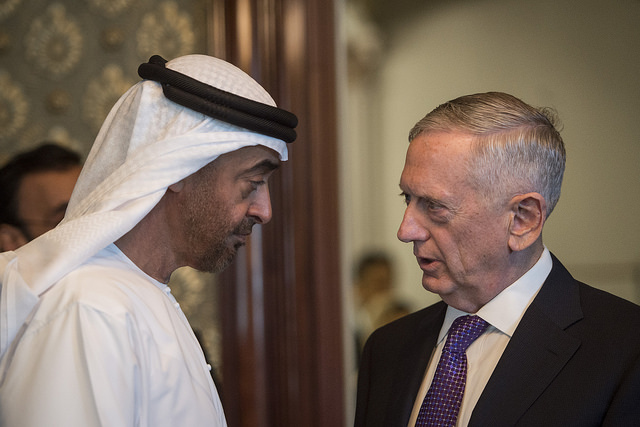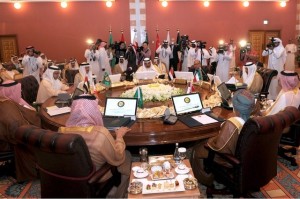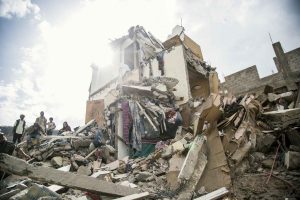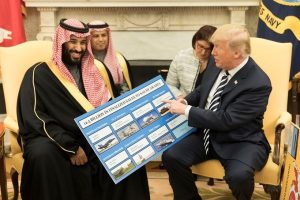by William D. Hartung
Discussions about the war in Yemen in the media and on Capitol Hill generally focus on the role of the Saudi-led bombing campaign, which has killed thousands of civilians while targeting hospitals, marketplaces, and even a funeral. Just last week, Amnesty International revealed details of a Saudi air strike that killed 16 civilians—including seven children—with a U.S.-supplied bomb.
To make matters worse, the Saudi regime has doggedly opposed efforts to establish an independent United Nations investigation of potential war crimes committed by all sides in the conflict. The Saudi role in contributing to what a UN official has described as “the world’s largest humanitarian crisis” has drawn growing criticism in Congress. In June, in response to Saudi actions in Yemen, 47 senators voted to block a sale of U.S. bombs to the regime.
But another U.S.-backed regime also bears a major share of responsibility for the devastating consequences of the Yemen war—the United Arab Emirates. The UAE has been the most important participant in the ground war and has participated in the naval blockade of Yemen that has made it extremely difficult to get humanitarian aid to those who need it. More recently, there have also been allegations that the UAE and its local allies have been running a network of secret prisons in Yemen where suspects are regularly subjected to brutal acts of torture, including a technique called “the grill,” which involves rotating a human being over a fire.
The United States has a longstanding, close relationship with the UAE military, grounded in the UAE’s participation in U.S.-led interventions in Somalia, Iraq (1991), Kosovo, Afghanistan, and Syria. The only exception to the rule was the Bush administration’s 2003 invasion of Iraq. Secretary of Defense James Mattis and other U.S. officials have long referred to the UAE as “Little Sparta” in recognition of the effectiveness of their air and ground forces. The tight connection between the two nations is further underscored by the fact that Mattis served as an unpaid advisor to the UAE military after retiring as the head of the U.S. Central Command and before joining the Trump administration as secretary of defense. And data from the Security Assistance Monitor indicates that the U.S. has trained more than 5,000 UAE military personnel since 2009.
The United States has played an enabling role in the UAE’s war effort in Yemen, supplying the bulk of its imported weaponry, training thousands of its military personnel, and refueling its aircraft. Many of the weapons supplied are directly relevant to the war in Yemen, including offers of over 30,000 bombs since the March 2015 Saudi-led intervention there. The Pentagon refuses to divulge how many of these bombs have been delivered to the UAE thus far, but if nothing else the scale of the offers indicates an endorsement of the UAE’s conduct in Yemen. In any case, more than half of the UAE’s air force is composed of U.S. supplied F-16s—souped-up models that are more capable than those possessed by the U.S. air force.
Although the Obama administration seemed to be internally divided about ongoing U.S. support for the Saudis and their allies in the Yemen conflict—as evidenced by the suspension of a sale of guided bombs late in Obama’s term—the Trump administration has no such reservations. President Trump buys the Saudi line that the Yemen war is simply a response to Iranian expansionism expressed via its support for the Houthi rebels who are fighting the Saudi-led coalition. But most experts on the region have noted that the Iranian role is limited and that the Houthi forces have longstanding grievances that would lead them to fight for a greater share of political and economic power within Yemen regardless of whether Iran was involved in the conflict.
The one ray of hope for U.S. policy is growing bipartisan opposition to the current approach of uncritical military backing of the Saudis and their allies in the war, led by members such as Sen. Chris Murphy (D-CT), Sen. Rand Paul (R-KY), Sen. Todd Young (R-IN), Rep. Ted Lieu (D-CA), and Rep. Ro Khanna (D-CA). Blundering ahead with the current approach does not serve U.S. interests, however narrowly defined, given that the arming of the Saudis and the UAE risks implicating Washington in war crimes even as it creates a chaotic situation that has made it easier for al-Qaeda in the Arabian Peninsula to make gains in Yemen.
A sounder U.S. policy towards Yemen should include support for an independent investigation of human rights abuses by all sides of the conflict, a suspension of U.S. arms and training to the Saudis and the UAE until allegations of torture and intentional targeting of civilians are resolved, and pressure on U.S. allies to participate in inclusive peace talks that take into account all parties to the dispute. Anything less will only lead to more needless suffering while undermining the security of the United States and the region.
William D. Hartung is the director of the Arms and Security Project at the Center for International Policy and the author of the Center’s new report, “U.S. Arms Transfers to the UAE and the War in Yemen.” Photo: Abu Dhabi’s Crown Prince Mohammed bin Zayed Al Nahyan meets with Secretary of Defense Jim Mattis (Jim Mattis via Flickr).






Not war IN Yemen- the northern border of Yemen is 1 mile north of Tarim and is parallel to the equator. There is an open area between Yemen and Saudi Arabia where raiders/killers hide behind the women and children- those are the people being attacked by Saudi Arabia and Yemen and the United States(only two times).
Wow! Very insightful!!!!!!
This is a criminal war bordering on the genocidal as all the victims are Yemeny killed
in their own homeland by bombs and disease .